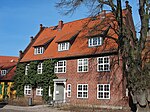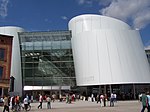Stralsund (German pronunciation: [ˈʃtʁaːlzʊnt] ; Swedish: Strålsund), officially the Hanseatic City of Stralsund (German: Hansestadt Stralsund), is the fifth-largest city in the northeastern German federal state of Mecklenburg-Western Pomerania after Rostock, Schwerin, Neubrandenburg and Greifswald, and the second-largest city in the Pomeranian part of the state. It is located on the southern coast of the Strelasund, a sound of the Baltic Sea separating the island of Rügen from the Pomeranian mainland.The Strelasund Crossing with its two bridges and several ferry services connects Stralsund with Rügen, the largest island of Germany and Pomerania. The Western Pomeranian city is the seat of the Vorpommern-Rügen district and, together with Greifswald, Stralsund forms one of four high-level urban centres of the region.
The city's name as well as that of the Strelasund are compounds of the Slavic (Polabian) stral and strela (arrow; Polish: strzała, Czech: střela) and the Germanic sund, a strait or sound. The canting arms of the city make reference to that etymology as well as to Stralsund's Hanseatic past in featuring a silver cross pattée (a Hanseatic Cross) above a silver arrow.
Stralsund was granted city rights in 1234 and is thus the oldest city in Pomerania. It was one of the most prosperous members of the medieval Hanseatic League. In 1628, during the Thirty Years' War, the city came under Swedish rule and remained so until the upheavals of the Napoleonic Wars. It was the capital of Swedish Pomerania (New Western Pomerania) from 1720 to 1815. From 1815 to 1945, Stralsund was part of Prussia.
Stralsund's old town was inscribed as a UNESCO World Heritage Site in 2002 alongside Wismar in Mecklenburg because of its outstanding Brick Gothic buildings and importance during the Hanseatic League and Swedish rule. St Mary's Church has been the tallest church in the world from 1549 to 1569 and from 1573 to 1647. The city's other two large churches are St Nicholas' and St James'. Stralsund is the seat of the German Oceanographic Museum (Deutsches Meeresmuseum) with its satellites Ozeaneum (in Stralsund), Nautineum (on Dänholm Island), and Natureum (on the Fischland-Darß-Zingst Peninsula).
The main industries of Stralsund are shipbuilding, fishing, mechanical engineering, and, to an increasing degree, tourism, life sciences, services and high tech industries, especially information technology and biotechnology.












